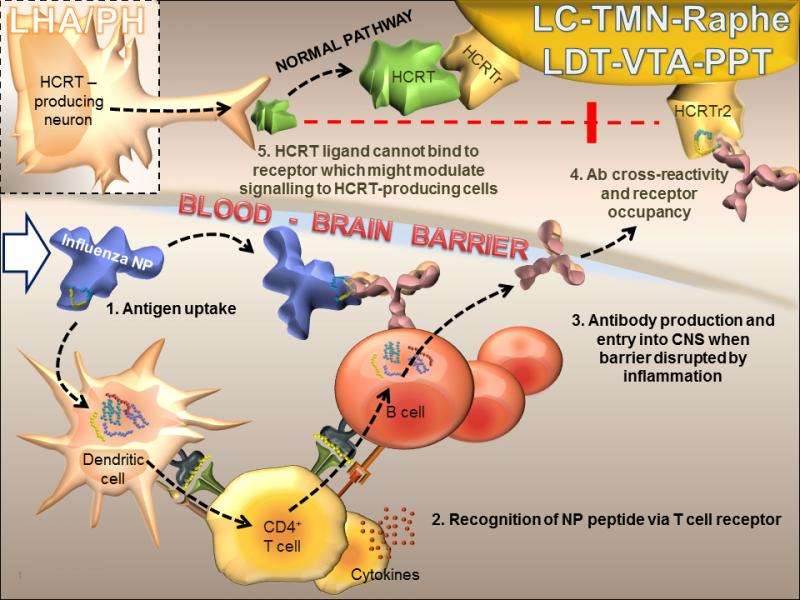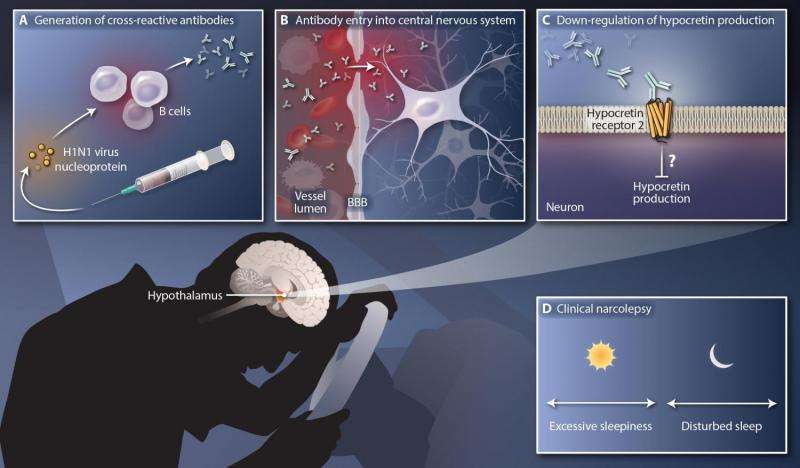Immune response to a flu protein yields new insights into narcolepsy

An international team of researchers has found some of the first solid evidence that narcolepsy may be a so-called "hit-and-run" autoimmune disease.
The researchers sought to determine why, of two different flu vaccines widely deployed during the 2009 swine flu pandemic, only one was associated with a spike in the incidence of narcolepsy, a rare sleep disorder.
A paper describing their findings will be published July 1 in Science Translational Medicine. Lawrence Steinman, MD, a professor of pediatrics and of neurology and neurological sciences, is the senior author. The first author is Sohail Ahmed, MD, who was global head of clinical sciences at Novartis Vaccines at the time of the study.
Autoimmune diseases, such as multiple sclerosis and rheumatoid arthritis, are well-known for taking decades to ravage the nervous system, joints or other organ systems. But since the late 1990s, researchers have hypothesized a different kind of autoimmune disease, one that may incur rapid, pinpoint damage and leave virtually no trace of its work. Narcolepsy is suspected of being one of these hit-and-run diseases.
Gene variants increase susceptibility
Narcolepsy is a chronic, incurable and lifelong brain disorder that interferes with normal sleep-wake cycles and causes an array of symptoms, including overwhelming daytime sleepiness and sleep attacks that can strike at any time—even in the middle of a conversation. What causes narcolepsy has been a source of fascination among scientists for decades.
Narcolepsy cases mostly occur at random, as opposed to being strictly inherited, although certain gene variants can make people more susceptible to it. For example, nearly everyone who has narcolepsy accompanied by cataplexy, a condition that causes sudden episodes of muscle weakness, carries a gene variant called HLA-DQB1*0602, which codes for a receptor found on the surface of immune cells.

"HLA variants are associated with a lot of autoimmune diseases," said Steinman, who also holds the George A. Zimmermann Professorship. But by themselves, they don't cause narcolepsy. Rather, the disease seems to be triggered by a combination of genetic predisposition and infection. People with narcolepsy carry more antibodies to pathogens such as strep bacteria or the H1N1 virus, which caused the 2009 swine flu pandemic. Importantly, narcoleptic patients have very low levels of the neurotransmitter hypocretin, which normally helps to keep us awake when it binds to the hypocretin receptors in the brain. They also have fewer of the brain neurons that produce hypocretin. What could explain this constellation of signs?
The answer began to emerge in 2010, soon after the 2009 pandemic, when researchers reported a sharp uptick in the diagnoses of new cases of narcolepsy—but only in some places. Populations that had been immunized with GlaxoSmithKline's Pandemrix vaccine showed an increase in narcolepsy, but those immunized with Novartis' Focetria did not.
The researchers wondered whether this difference could be explained by the fact that Pandemrix and Focetria were made from two different strains of the H1N1 virus. The team found that H1N1 contains a protein whose structure partially mimics a portion of a human hypocretin receptor. This H1N1 protein was contained, as expected, in the Pandemrix vaccine, but at much higher amounts than that found in the Focetria vaccine. Could antibodies normally generated to this flu protein by Pandemrix vaccination also be latching onto hypocretin receptors and causing an autoimmune reaction?
"It was a really exciting moment," Steinman said.
To find out if narcoleptic patients even had such antibodies, the team examined a sample of 20 individuals who developed narcolepsy after Pandemrix vaccination. Seventeen of them had elevated antibodies to the hypocretin receptor. However, among six individuals immunized with Focetria, none had these antibodies.
How H1N1 and Pandremix might cause narcolepsy
The authors propose a hit-and-run autoimmune mechanism for how both swine flu and Pandemrix might cause narcolepsy. They suggest that in genetically predisposed people, high levels of the H1N1 protein stimulate the production of large amounts of antibodies to both the virus and the hypocretin receptor. These antibodies may persist in the blood for months. Either the large numbers of antibodies or inflammation from an unrelated infection could alter the blood-brain barrier, allowing the antibodies to enter the brain. There, the antibodies may latch onto hypocretin receptors, possibly directing the immune system to destroy or suppress brain cells critical to regulating sleep-wake cycles.
Indeed, compared to Pandemrix, Focetria contains 72 percent less of the H1N1 protein and, for this reason, it doesn't appear to have stimulated specific flu antibodies capable of binding to the receptor, according to the researchers.
Because Pandemrix was associated with an increased risk of narcolepsy, it was withdrawn from the market. But Steinman is quick to point out that, even with that risk, the vaccine was far safer than being infected with swine flu. In the United States alone, the 2009 swine flu pandemic resulted in 274,304 hospitalizations and 12,469 deaths.
The work advances the understanding of narcolepsy, but Steinman said he isn't claiming they have nailed down the cause. For now, he's calling the proposed mechanism "an inviting possibility." Future work could include comparisons of different vaccines and in vitro studies of banked human blood samples.
Other Stanford co-authors of the paper are senior research scientist Jonathan Rothbard, PhD, and Christopher Adams, PhD, director of proteomics at the Stanford University Mass Spectrometry Laboratory.
More information: Antibodies to influenza nucleoprotein cross-react with human hypocretin receptor 2, Science Translational Medicine, stm.sciencemag.org/lookup/doi/ … scitranslmed.aab2354
















